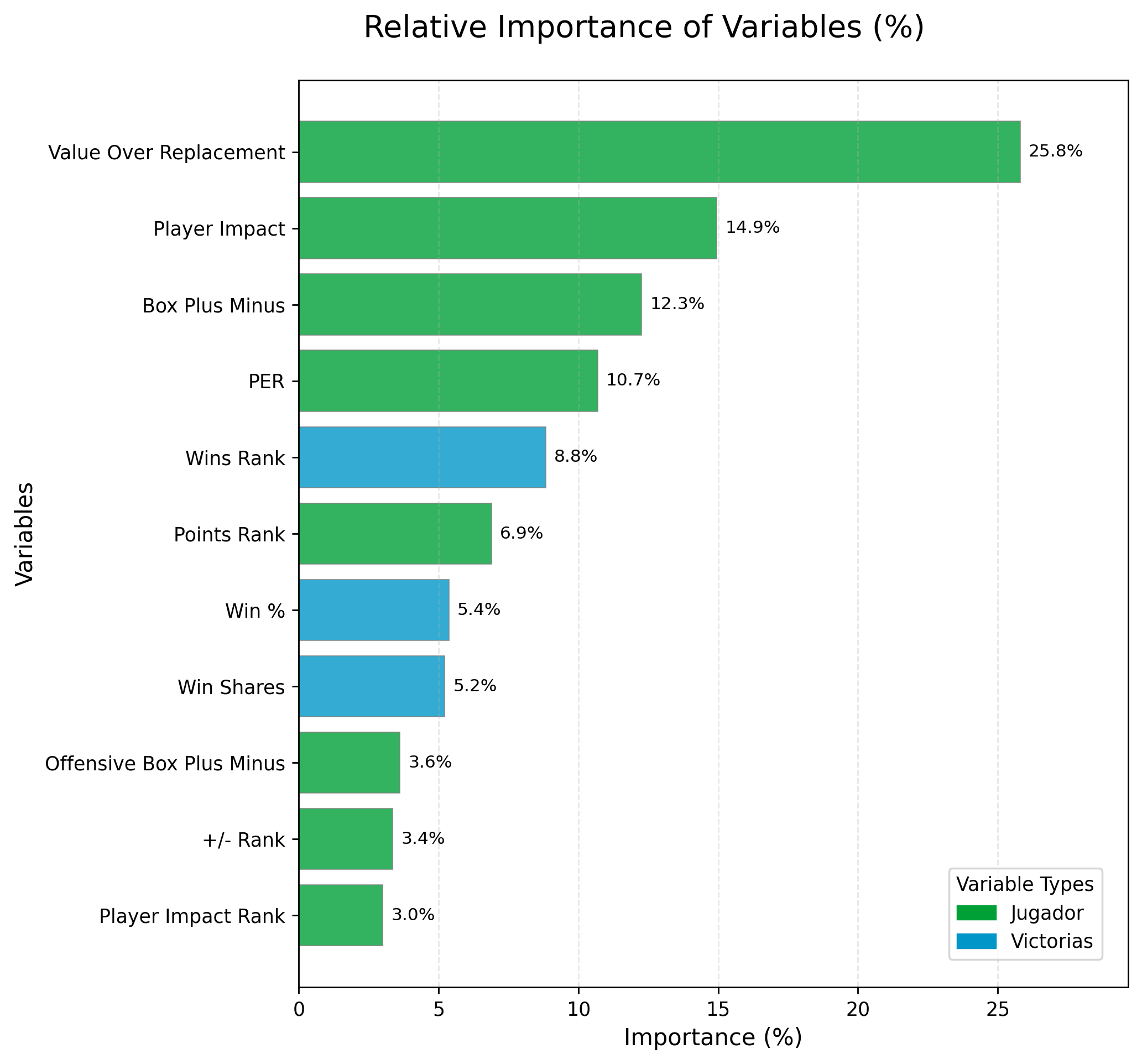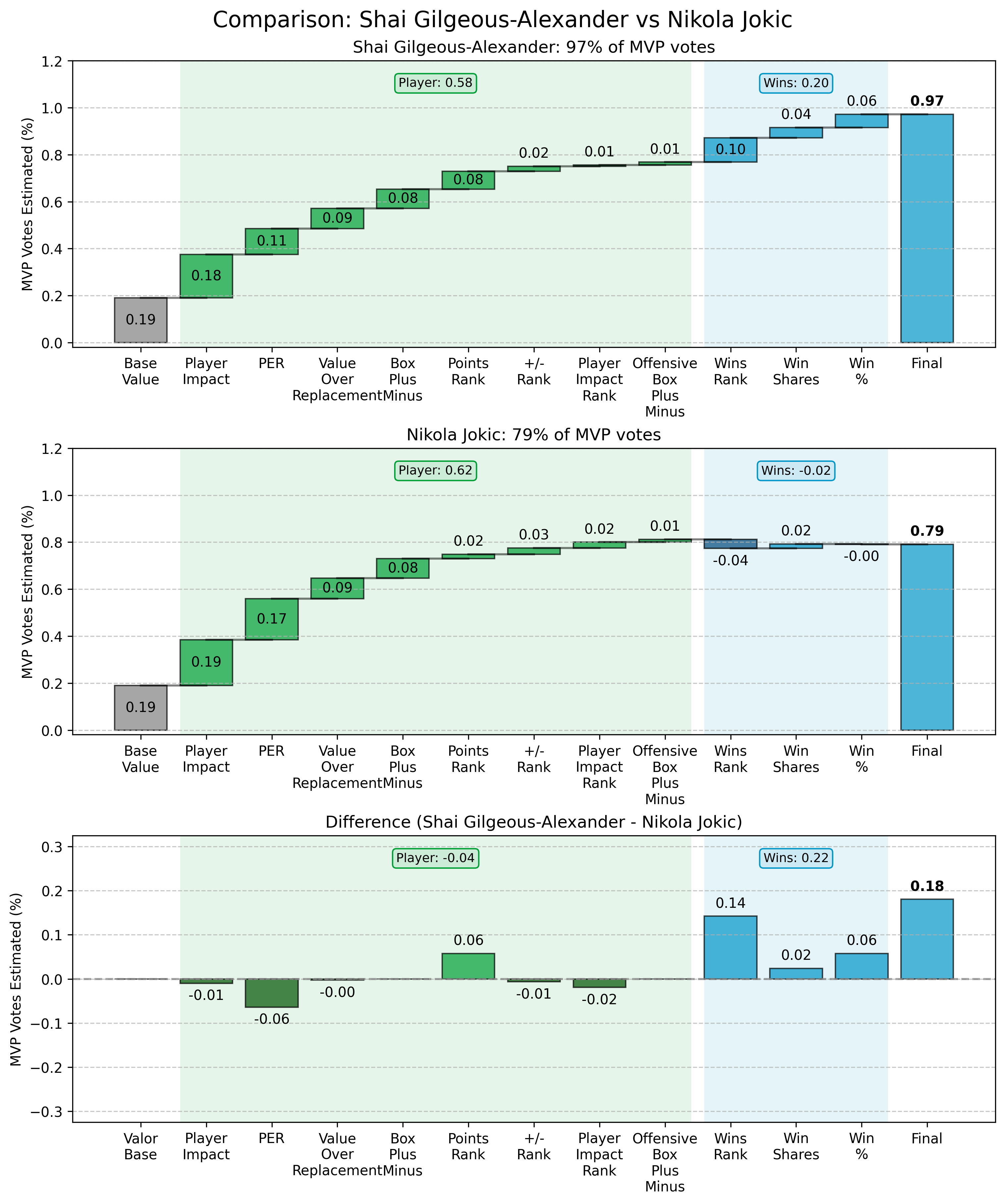
A few days ago, the NBA announced its three finalists for the MVP award: Shai Gilgeous-Alexander, Nikola Jokic, and Giannis Antetokounmpo. In particular, the first two have completed a magnificent year, which without the presence of the other, would make them worthy of the award. In this article, we will delve into details about their season, predict how the voting will turn out, and examine which metrics have the most impact when choosing the winner.
The candidates
- Shai Gilgeous-Alexander has led the Oklahoma City Thunder to the best record in the league, with an incredible 68-14 placing them as the seventh-best mark in history. For his part, he has been the season’s leading scorer (32.7 points), with a 52% field goal percentage that is very high for his position as a perimeter player.
- Nikola Jokic has managed to finish in the top-3 in points, assists, rebounds, and steals, something that had never happened before. However, Denver finished in fourth place in a very competitive Western Conference, which may penalize him when it comes to voting.
- Giannis Antetokounmpo has finished as the second-highest scorer with 30.4 points, to which he has added 11.9 rebounds and 6.5 assists, very much in line with what he has been offering in recent campaigns.
The general statistics of the candidates are as follows:
| Player | Team Record | Points | Rebounds | Assists | FG% | 3P% | FT% |
| Shai | 68-14 (1st) | 32.7 | 5.0 | 6.4 | 51.9% | 37.5% | 89.8% |
| Jokic | 50-32 (7th) | 29.6 | 12.7 | 10.2 | 57.6% | 41.7% | 80.0% |
| Giannis | 48-34 (9th) | 30.4 | 11.9 | 6.5 | 60.1% | 22.2% | 61.7% |
In the following chart we can see the shot selection of each of them: Shai has a general dispersion throughout the court, as he is an expert in mid-range, Jokic alternates the post with frontal 3-point shots, and Giannis focuses on drives, so most of his shots are in the vicinity of the basket (TODO REVISAR).

Advanced Stats
In addition to simple statistics such as points, rebounds, or assists, there are more complex metrics that allow us to better evaluate player performance:
- Player Impact Estimate (PIE): Percentage that measures a player’s total contribution on the court. 10% is average, 15% or more indicates a star. It summarizes everything good (points, rebounds, assists) and bad (turnovers, fouls) that a player does.
- PER: A rating that combines all statistics into a single number. The league average is 15, All-Star players typically have a PER above 20, and Michael Jordan’s career PER is 27.9.
- Value Over Replacement Player (VORP): Measures how much better a player is than the replacement coming off the bench.
- Box Plus Minus (BPM): Indicates how many points per 100 possessions a player contributes above or below average. +5.0 is excellent, 0.0 is average, -2.0 is poor.
- Offensive Box Plus Minus: The portion of BPM that only considers offensive contribution. Measures offensive contribution compared to an average player.
- Win Shares: Estimates the number of wins a player has contributed to his team. A star can generate 10-15 wins per season. It translates statistics into something concrete: how many wins he helped achieve.
| Jugador | Valor sobre recambio | Impacto (PIE) | PER | Box Plus Minus | Box Plus Minus Ofensivo | Victorias Generadas |
| Shai | 8.9 (2nd) | 0.199 (3rd) | 30.7 (2nd) | 11.5 (2nd) | 8.9 (2nd) | 16.7 (1st) |
| Jokic | 9.8 (1st) | 0.206 (2nd) | 32.0 (1st) | 13.3 (1st) | 9.9 (1st) | 16.4 (2nd) |
| Giannis | 6.6 (3rd) | 0.210 (1st) | 30.5 (3rd) | 9.5 (3rd) | 6.9 (3rd) | 11.5 (5th) |
The first thing that catches our attention in the table is that they have been the 3 best in the league in all these metrics, except for Giannis’ fifth place in Win Shares. Jokic dominates in 4 of these categories, although Shai is very close to him. Giannis is further behind, but only because his two rivals’ seasons have been truly extraordinary.
How the MVP is Voted
The voting is in the hands of a panel of approximately 100 journalists and specialized analysts, selected by the NBA itself. Voters cast their choices at the end of the regular season (playoffs don’t count). Each voter must choose their top 5 MVP candidates, and each position is assigned a point value:
- 1º: 10 puntos
- 2º: 7 puntos
- 3º: 5 puntos
- 4º: 3 puntos
- 5º: 1 punto
Finally, the points for each player are added up, and the one with the most total points takes the trophy. For example, last year’s voting turned out like this:
| Position | Player | Points | Percentage of maximum points |
|---|---|---|---|
| 1st | Nikola Jokic | 926 | 93.5% |
| 2nd | Shai Gilgeous-Alexander | 640 | 64.6% |
| 3rd | Luka Doncic | 566 | 57.2% |
| 4th | Giannis Antetokounmpo | 192 | 19.4% |
| 5th | Jalen Brunson | 142 | 14.3% |
Developing a Predictive Model
Our goal is to predict who will be the NBA MVP, based on results from other years, and to isolate and understand the characteristics that make a player win the trophy. To make metrics comparable across all years, we’ll focus on the percentage of points obtained out of the total possible.
With this in mind, we have created an analytical model trained with data from the main MVP candidates from the 1996/97 season to the 2021/22 season, providing it with statistical data from this period, with traditional and advanced metrics, awards and selections to All-NBA teams, reaching almost 400 indicators.
Our model has evaluated all this data, selecting the variables that best help predict how close a player is to winning the MVP. To verify that it works correctly, we have tested it against the results of the year 2024.
| Position | Player | Points | Percentage of maximum | Prediction |
|---|---|---|---|---|
| 1.º | Nikola Jokic | 926 | 93.5% | 90.6% |
| 2.º | Shai Gilgeous-Alexander | 640 | 64.6% | 60.9% |
| 3.º | Luka Doncic | 566 | 57.2% | 57.5% |
| 4.º | Giannis Antetokounmpo | 192 | 19.4% | 35.8% |
| 5.º | Jalen Brunson | 142 | 14.3% | 11.1% |
Looking at the results, it seems that the model works well and is able to predict the ranking in the correct order. However, what makes a player an MVP?
Understanding the Model
As we said, we have almost 400 indicators, but logically we are not going to use them all. Through automatic selection, the model is able to find the most important ones, and from there it is easier to refine until we reach our final set of variables.

As we can see, most of them are advanced stats, and we can observe two clear groups: individual statistics and variables related to the number of victories. This fits perfectly with the criteria we would expect from an MVP winner: they must have had a great individual campaign, but they must also have lifted their team to one of the top spots in the competition.
Predicting the Winner
Now all that remains is the most interesting part, who will win the 2025 MVP? With our model in hand, this is what we get:
| Position | Player | Prediction |
|---|---|---|
| 1st | Shai Gilgeous-Alexander | 97.1% |
| 2nd | Nikola Jokic | 79.2% |
| 3rd | Giannis Antetokounmpo | 44.3% |
It seems that the model follows the idea we had in mind: although Jokic and Shai have both done more than enough to win, the MVP goes to the Thunder’s point guard. However, why has it been this way? Let’s look at the prediction in a disaggregated form:

In the graph above, we see how each variable contributes to the final prediction. Both candidates start with a base value of 0.19 (prediction of an average MVP candidate based on what we’ve seen in past years), and they add or subtract points based on their performance in each category.
When dividing the variables into two groups (player impact and victories achieved), we see that in the player part, Jokic has a slight advantage over Shai (we’ve verified this by looking at their advanced stats), but Oklahoma’s better performance (which has secured no less than 18 more wins than Denver) is more than enough to tip the balance in favor of the point guard.
The importance of narratives
I cannot end this article without emphasizing that models are not crystal balls. For starters, they only have the information we give them, and they are not influenced by narratives and interests, for better or worse.
For example, two years ago, Embiid won the MVP over Jokic, and even though both had great seasons, an important part of this decision was the so-called “voter fatigue,” since the Serbian already had 2 consecutive awards. The same has happened to LeBron or Giannis on other occasions. Although the model knows how many MVPs each player has won in the past, it doesn’t have that sensitivity to journalistic campaigns for or against candidates; it only sees the raw data.
In the coming days, we will find out, and we will see how accurate our prediction has been. Do you agree with the model, or do you think there are more factors to consider? We’ll read you in the comments!
Discover more from SospiAnalytics
Subscribe to get the latest posts sent to your email.